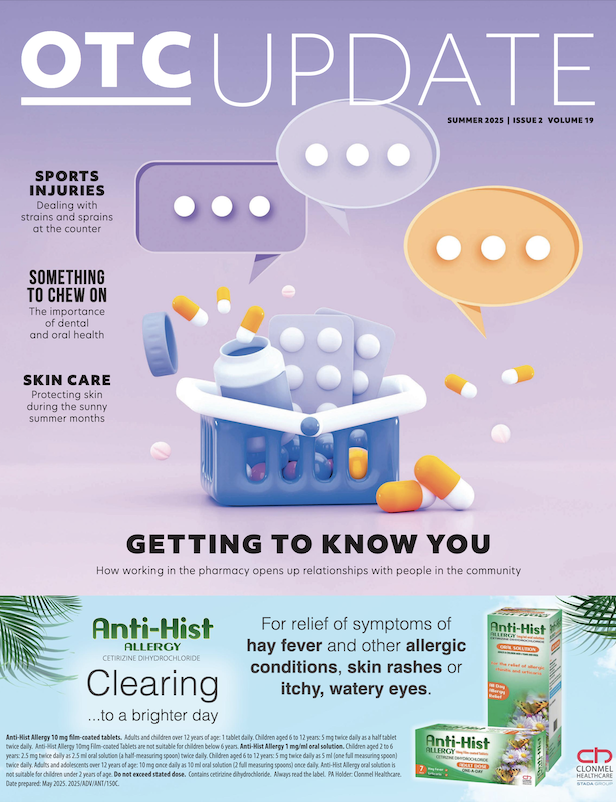This CPD module provides an outline of what pharmacists and pharmacy staff need to know about OTC medicines. On completion of this module, it is expected the reader will have an enhanced understanding of some of the most common OTC medications, including interactions, common side- effects, contraindications, and more. This module can also serve as a quick-reference guide for the most common OTC medications
This article discusses the most widely-used over-the-counter (OTC) medicines used worldwide in pharmacies. Discussed are clinical details such as indications, side- effects, contraindications, interactions, recommended doses, and more. Additionally, general safety considerations, abuse potential, random facts, and historical background are provided.
With pharmacists getting more responsibilities worldwide with the aim of using pharmacists’ expertise to take pressure of health services that are overstretched in most countries, part of better utilisation of pharmacists’ time is by taken changing more medicines from ‘prescription only’ to ‘pharmacy only/OTC.
This introduction of pharmacist prescribing and the likes of ‘minor ailment schemes’ funded by health services in many countries empowers pharmacists to diagnose, recommend products or decide to refer to GPs if needed. There is evidence of more and more conditions where this has worked well. It has seen pressure taken off GPs and better patient outcomes, like shorter waiting times, etc. This article does
not refer to these schemes, but aims to give a summary of the most popular medicines sold by pharmacies without need for prescriptions worldwide.
Use per country varies depending on product, however I list and discuss 16 of the most common OTC products worldwide, from the number one OTC drug sold and used (paracetamol), and list in order of average worldwide usage.
1. Paracetamol
Indications
- Mild-to-moderate pain.
- Fever.
Common side-effects
- Generally, well tolerated at standard doses.
- Overdose can lead to severe liver damage and potentially fatal hepatic failure.
Contraindications
- Severe liver impairment.
- Chronic alcohol misuse.
- Hypersensitivity to paracetamol or formulation excipients.
Drug interactions
- Warfarin (may increase INR).
- Hepatotoxic drugs (ie, isoniazid).
- Enzyme inducers (ie, carbamazepine).
Effects of drug interactions
- Enhanced bleeding risk with warfarin.
- Increased hepatotoxicity with other liver- metabolised drugs.
- Faster conversion to toxic metabolites with enzyme inducers.
Effects on contraindicated patients: As per NICE guidance
- Liver failure, encephalopathy, and death if used in hepatic impairment or with alcohol excess.
Recommended daily dose
Maximum 4g/day for adults (ie, 8x500mg tablets). Minimum 4–6 hours between doses.
Abuse potential
Low under normal use. However, intentional overdose for self-harm is common in emergency departments.
General risk factors:
As per NICE guidance
- Safe for elderly with normal liver function.
- Well tolerated in pregnancy.
- Caution in liver disease.
- Preferred when NSAIDs are contraindicated.
- Use for mild pain and fever.
- Cardiovascular: Minimal direct effect.
- Liver: Significant risk in hepatic impairment or alcohol misuse.
- Kidney: Risk of renal tubular necrosis in massive overdose.
- Diabetes: Safe in standard doses
- Elderly: safe if dosing guidance is followed.
Random fact
Paracetamol has been carried on space missions as a first-line analgesic for astronauts.
Launch and global usage info
- Invented: 1878 by Harmon Northrop Morse at Johns Hopkins University in Baltimore, USA.
- First marketed: 1956 as Panadol by Frederick Stearns and Co (a US Firm) and was first launched in the UK.
- Global usage rank: #1 – most commonly used OTC analgesic worldwide.
2. Ibuprofen
Indications
- Pain.
- Inflammation.
- Fever.
Common side-effects
- Gi irritation, dyspepsia.
- Ulcers, bleeding.
- Rare: Renal impairment with long-term use.
Contraindications
- Active ulcers or Gi bleeding.
- Severe heart failure.
- Renal impairment.
- Hypersensitivity to NSAIDs.
Drug interactions
- Antihypertensives (reduces effect).
- Warfarin, aspirin (increases bleeding risk).
- Corticosteroids (Gi side-effects).
Effects of drug interactions
- Increased risk of GI bleeding and ulceration with corticosteroids or anticoagulants.
- Diminished BP control with hypertensives.
It has seen pressure taken off GPs and better patient outcomes
Effects on contraindicated patients: As per NICE guidance
- Avoid in third trimester of pregnancy.
- Best taken with food.
- Caution with renal or cardiac impairment.
- Avoid in peptic ulcer or GI bleed history.
- Short-term use for pain and inflammation.
- Can trigger severe Gi bleeding, renal decompensation, heart failure exacerbation.
Recommended daily dose
1,200–2,400 mg/day for adults, divided into 3–4 doses. Take With food.
Abuse potential
Low, though chronic use for headaches or pain masking can lead to misuse patterns.
General risk factors
- Cardiovascular: May raise BP and risk of MI/stroke.
- Liver: Rarely hepatotoxic.
- Kidney: Risk of nephrotoxicity.
- Diabetes: May worsen renal status.
- Elderly: Higher risk of Gi bleeding and renal issues.
Random facts
Ibuprofen was originally evaluated and developed to treat rheumatoid arthritis only. Dr Stewart Adams (its inventor) used it to treat his own hangovers.
Launch and global usage info
- Invented: 1961 by Dr Stewart Adams at Boots Pure Drug Company (who were part of the famous British Boots Chemist Chain). Boots no longer has a manufacturing arm.
- First marketed: 1969 as Brufen.
- Global usage rank: #2 – widely used NSAID for pain and inflammation.
3. Aspirin
Indications
- Mild pain, fever, inflammation.
- Low dose for antiplatelet effect.
Common side-effects
- Gi irritation.
- Bleeding.
- Tinnitus at high doses.
Contraindications: as per NICE guidance
- Risk of bleeding increases with alcohol.
- Avoid with anticoagulants unless directed.
- Can irritate stomach lining.
- Avoid in children under 16 (Reye’s syndrome).
- Children under 16 (Reye’s syndrome).
- Active ulcers.
- Bleeding disorders.
Drug interactions
- Anticoagulants.
- NSAIDs.
- Methotrexate.
Effects of drug interactions
Increased bleeding risk or methotrexate toxicity.
Effects on contraindicated patients GI hemorrhage, excessive bruising, or neurologic risk in children.
Recommended daily dose
Pain relief: 300–900 mg every 4–6 hours; max 4g/day. Antiplatelet: 75–150 mg daily.
Abuse potential
Low, but overdose can be life-threatening due to acidosis and bleeding.
General risk factors
- Cardiovascular: Protective in low doses.
- Liver: Use with caution in dysfunction.
- Kidney: Avoid in renal impairment.
Aspirin was originally derived from willow bark, used for centuries in folk medicine
- Diabetes: May worsen glycemic variability.
- Elderly: Increased Gi and bleeding risk.
Random fact
Aspirin was originally derived from willow bark, used for centuries in folk medicine.
Launch and global usage info
- Invented: 1897 by Felix Hoffmann at Bayer.
- First marketed: 1899.
- Global usage rank: #3 – common for pain relief and cardiovascular protection.
NICE guidance
- Caution in liver impairment.
- Minimal CNS penetration.
- Safe for long-term use.
- Non-sedating option.
- Preferred in allergic rhinitis.
4. Loratadine
Indications
- Allergic rhinitis/Hay fever.
- Urticaria.
Common side-effects
- Headache.
- Dry mouth.
- Fatigue.
Contraindications
Severe liver dysfunction.
Drug interactions
Ketoconazole, erythromycin (increased serum levels).
Effects of drug interactions
Elevated plasma concentration, possible QT prolongation.
Effects on contraindicated patients
Increased sedation risk or hepatic accumulation.
Recommended daily dose
10mg once daily for adults and children over six years.
Abuse potential
None: Not associated with misuse or dependence.
General risk factors
- Cardiovascular: Safe.
- Liver: Dose adjustment in impairment.
- Kidneys: Minimal involvement.
- Diabetes: No interference.
- Elderly: Well-tolerated.
NICE guidance
- Safe for most adults and children wover six years.
- Adjust dose in renal impairment.
- Avoid alcohol when taking.
- Can cause drowsiness in some people.
- Effective for hay fever and hives.
Random fact
Loratadine is considered non-drowsy antihistamine, but in high doses it can still cause sedation.
Launch and global usage info
- Invented: 1980 by Schering-Plough.
- First marketed: 1993 as Claritin.
- Global usage rank: #4 – popular second- generation antihistamine.
5. Cetirizine
Indications
- Hay fever/Allergic rhinitis.
- Urticaria.
Common side-effects
- Mild drowsiness.
- Dry mouth.
- Dizziness.
Contraindications
Severe renal impairment.
Drug interactions
- Alcohol and sedatives (CNS depression).
Effects of drug interactions
- Additive sedation.
- Impaired co-ordination.
Effects on contraindicated patients
Risk of drug accumulation and prolonged effects.
Recommended daily dose
10mg once daily for adults and for children, 5–10 mg daily depending on age.
Abuse potential
None – rarely misused.
General risk factors
- Cardiovascular: Safe.
- Liver: Caution in dysfunction.
- Kidneys: Dose adjust in impairment.
- Diabetes: Neutral effect.
- Elderly: Monitor for sedation.
Random fact
Cetirizine is a metabolite of hydroxyzine. Hydroxyzine is a now rarely used first- generation antihistamine due to side effects like drowsiness.
Launch and global usage info
- Invented: 1980s by UCB Pharma.
- First marketed: 1987 as Zirtec.
- Global usage rank: #5 – widely used for allergy relief.
NICE guidance
- Suitable for daily use.
- Adjust dose in renal impairment.
- Can cause mild drowsiness.
- Useful for seasonal allergies and urticaria.
- Non-sedating antihistamine.
6. Chlorphenamine
Indications
- Hay fever/Allergic rhinitis.
- Drug-induced allergy.
Common side-effects
- Drowsiness.
- Dry mouth.
- Blurred vision.
Contraindications
- Glaucoma.
- Urinary retention.
- Enlarged prostate.
Drug interactions
- CNS depressants.
- MAOIs.
Effects of drug interactions
Increased sedation or anticholinergic effects.
Effects on contraindicated patients
May worsen urinary retention or cause intraocular pressure rise.
Recommended daily dose
4mg every 4–6 hours; max 24mg/day for adults.
Abuse potential
Low, but sedative effects can lead to misuse in combination with other depressants.
General risk factors
- Cardiovascular: Generally negligible risk.
- Liver: Metabolised hepatically.
- Kidney: Monitor in impairment.
- Diabetes: No effect.
- Elderly: More sensitive to sedative effects.
Random fact
This medicine has been included in cold and flu remedies since the 1950s.
Launch and global usage info
- Invented: 1948.
- First marketed: 1949 by Schering Corporation.
- Global usage rank: #6 – Common first- generation antihistamine.
NICE guidance
- Interactions with alcohol and sedatives.
- Short-term use only.
- Avoid in older adults – anticholinergic effects.
- Causes significant drowsiness.
- Can be used for insomnia and allergies.
7. Diphenhydramine
Indications
- Short-term insomnia.
- Allergy symptoms.
Common side-effects
- Drowsiness.
- Dizziness.
- Dry mouth.
Contraindications
- Asthma.
- Glaucoma.
- Prostatic hypertrophy.
Drug interactions
- Alcohol.
- Sedatives.
- Anticholinergics.
Effects of drug interactions
May cause excessive CNS depression or confusion.
Effects on contraindicated patients
Can precipitate asthma attacks or cause acute retention.
Recommended daily dose
25–50mg at bedtime (for sleep); up to 300mg/day for allergies.
Abuse potential
Moderate – can cause hallucinations or euphoria at high doses.
General risk factors
- Cardiovascular: Caution in arrhythmias.
- Liver: Processed by liver enzymes.
- Kidney: No major concern.
- Diabetes: No effect.
- Elderly: High fall and delirium risk.
Random fact
Originally developed as an antihistamine, it later gained popularity as a sleep aid.
Launch and global usage info
- Invented: 1943 by George Rieveschl.
- First marketed: 1946 as Benadryl by Parke-Davis.
- Global usage rank: #7 – widely used as antihistamine and sedative.
NICE guidance
- Caution in patients with glaucoma.
- Can impair cognitive function.
- Risk of confusion and dry mouth.
- High anticholinergic burden in elderly.
- Short-term use for allergy or sleep aid.
- Used for urticaria and cold symptoms.
- Causes drowsiness – avoid driving.
- Older sedating antihistamine.
8. Loperamide
Indications
- Diarrhoea (acute and travelers).
- Irritable bowel syndrome with diarrhoea.
Common side-effects
- Constipation.
- Abdominal cramps.
- Nausea.
Contraindications
- Dysentery.
- Ulcerative colitis.
- Bacterial enterocolitis.
Drug interactions
- Quinidine.
- Ritonavir.
Effects of drug interactions
May increase systemic levels of loperamide, increasing risk of cardiac side-effects.
Effects In contraindicated patients
May worsen underlying infection or lead to toxic megacolon.
Recommended daily dose
Initial 4mg, followed by 2mg after each loose stool (max 8mg/day).
Abuse potential
Moderate – misuse at high doses can cause euphoria or cardiac toxicity.
General risk factors
- Cardiovascular: Risk of QT prolongation at high doses.
- Liver: Caution in hepatic impairment.
- Kidney: No significant issues.
- Diabetes: Can be used safely.
- Elderly: Increased sensitivity to GI effects.
Random fact
Although meant to stay in the gut, at high doses it can cross the blood-brain barrier, causing opioid-like effects.
Launch and global usage info
- Invented: 1969 by Dr Paul Janssen.
- First marketed: 1973 as Imodium by Janssen Pharmaceutica.
- Global usage rank: #8 – Commonly used antidiarrheal agent.
NICE guidance
- Safe in IBS-related diarrhoea.
- Avoid in infective diarrhoea.
- Not for long-term use.
- Reduces gut motility.
- Used in acute diarrhoea. 9. Omeprazole
Indications
- Gastroesophageal reflux disease (GERD).
- Peptic ulcers.
- Heartburn.
Common side-effects
- Headache.
- Abdominal pain.
- Flatulence.
Contraindications
Hypersensitivity to PPIs.
Drug interactions
- Warfarin.
- Clopidogrel.
- Phenytoin.
Effects of drug interactions
Altered metabolism, potential increase or decrease in therapeutic effects.
Effects in contraindicated patients
Hypersensitivity reactions or suboptimal response to treatment.
Recommended daily dose
20mg once daily before breakfast; max 40mg/day unless advised.
Abuse potential
None – not habit-forming or psychoactive.
General risk factors
- Cardiovascular: Safe.
- Liver: Metabolised hepatically.
- Kidney: Minimal renal clearance.
- Diabetes: Safe.
- Elderly: Long-term use linked to fracture and B12 deficiency.
Random fact
This drug was the first proton pump inhibitor (PPI) and revolutionised acid- related treatments as PPIs are more effective than anything that same before.
Launch and global usage info
- Invented: 1979 by Astra AB.
- First marketed: 1989 as Losec.
- Global usage rank: #9 – Widely used proton pump inhibitor.
NICE guidance
- May reduce magnesium with prolonged use.
- Safe in H.pylori eradication regimens.
- Long-term use requires monitoring.
- Take before meals for the best effect.
- Used for reflux, ulcers, indigestion.
10. Gaviscon (Alginates)
Indications
- Heartburn.
- Indigestion.
- Acid reflux.
Common side-effects
- Bloating.
- Nausea (rare).
Contraindications
Sodium-restricted diets (check formulation).
Drug interactions
Iron and tetracyclines (absorption interference).
Effects of drug interactions
Reduced efficacy of interacting medicines.
Recommended daily dose
10–20mL after meals and at bedtime or 2–4 tablets post meals/bedtime.
Abuse potential
None – does not cause dependence or psychoactive effect.
General risk factors
- Cardiovascular: Watch sodium load.
- Liver: Safe.
- Kidney: Avoid high sodium loads.
- Diabetes: Sugar-free versions recommended.
- Elderly: Safe.
Random fact
Gaviscon forms a foamy ‘raft’ barrier on top of stomach contents to block reflux mechanically.
Launch and global usage info
- Invented: 1960s.
- First marketed: 1960s by Reckitt Benckiser.
- Global usage rank: #10 – Popular antacid and reflux remedy.
NICE guidance
- Useful in mild indigestion.
- Not absorbed systemically.
- Best after meals and at bedtime.
- Safe in pregnancy.
- Forms raft to reduce acid reflux.
11. Senna
Indications
Occasional constipation.
Common side-effects
- Abdominal cramping.
- Diarrhoea.
- Bowel dependency if misused.
Contraindications
- Bowel obstruction.
- Undiagnosed abdominal pain.
- Inflammatory bowel disease.
Drug interactions
- Diuretics, digoxin (potassium loss).
Effects of drug interactions
Can intensify digoxin effects or diuretic imbalance.
Effects in contraindicated patients
Potential bowel perforation or electrolyte imbalance.
Recommended daily dose
15mg at bedtime (standard); lower doses for mild cases.
Abuse potential
Moderate – chronic overuse may lead to dependency.
General risk factors
- Cardiovascular: Monitor electrolytes if on heart meds.
- Liver: Safe.
- Kidney: Dehydration risk if overused.
- Diabetes: Potential fluid shift.
- Elderly: Use with care.
Random fact
Senna is derived from a plant used in Ancient Egypt over 3,000 years ago.
Launch and global usage info
- Traditional use: Ancient medicine.
- First modern use: 1950s in pharmaceuticals.
- Global usage rank: #11 – Common stimulant laxative.
Senna is derived from a plant used in Ancient Egypt over 3,000 years ago
NICE guidance
- Available as tablets or syrup.
- Acts in 6–12 hours.
- May cause abdominal cramps.
- Stimulant laxative for short-term constipation.
- Maintain hydration during use.
- Can cause cramping.
- Avoid prolonged use due to dependency.
- Stimulant laxative for constipation.
12. Mebeverine
Indications
- Irritable bowel syndrome (IBS).
- Intestinal spasms.
Common side-effects
- Nausea.
- Headache.
- Indigestion.
Contraindications
Known hypersensitivity.
Drug interactions
Non-significant.
Effects of drug interactions
Not applicable.
Effects in contraindicated patients
Allergic reactions possible.
Recommended daily dose
135mg three times daily, 20 minutes before meals.
Abuse potential
None.
General risk factors
- Cardiovascular: Safe.
- Liver: Safe
- Kidney: Safe.
- Diabetes: No known impact.
- Elderly: Well tolerated.
Random fact
Unlike many antispasmodics, Mebeverine does not cause drowsiness.
Launch and global usage info
- Invented: 1965.
- First marketed: By Solvay Pharmaceuticals.
- Global usage rank: #12 – Common antispasmodic for IBS.
NICE guidance
- Take 20 minutes before meals.
- No sedation effect.
- Does not affect gut motility.
- Reduces smooth muscle spasm.
- Antispasmodic for IBS.
- Fluid retention or elevated blood pressure in sodium-sensitive patients.
13. Hydrocortisone cream
Indications
- Mild eczema.
- Dermatitis.
- Insect bites.
Common side-effects
- Skin thinning (if overused).
- Irritation.
- Burning sensation.
Contraindications
- Broken skin.
- Untreated skin infections.
Drug interactions
No significant interactions topically.
Effects of drug interactions
Systemic absorption minimal if used correctly.
Effects in contraindicated patients
Increased risk of infection or skin damage.
Recommended daily dose
Apply thin layer 1–2 times daily to affected area.
Abuse potential
None (unless misused chronically).
General risk factors
- Cardiovascular: Safe topically.
- Liver/kidney: Not systemically absorbed.
- Diabetes: Prolonged use may affect glucose in rare cases.
- Elderly: Thin skin increases risk of side- effects.
Random fact
Hydrocortisone is identical to the cortisol hormone produced by your adrenal glands.
Launch and global usage info
- Invented: 1950s.
- First marketed: By Upjohn.
- Global usage rank: #13 – widely used mild topical steroid.
NICE guidance
- Limit duration to reduce thinning risk.
- Avoid use on broken skin.
- Apply thinly, once or twice daily.
- Used for eczema, dermatitis, bites.
- Mild topical corticosteroid.
14. Clotrimazole
Indications
- Athlete’s foot.
- Fungal skin infections.
- Vaginal thrush.
Common side-effects
- Skin irritation.
- Stinging.
- Redness.
Contraindications
Hypersensitivity to imidazoles.
Drug interactions
Topical interactions rare; avoid mixing products.
The compound was one of the first azole antifungals approved for OTC use
Effects of drug interactions
Potential product inactivation, ie, using with other creams can/will dilute its effect.
Effects in contraindicated patients
Possible allergic dermatitis.
Recommended daily dose
Apply 2–3 times daily to affected area for 2–4 weeks.
Abuse potential
None.
General risk factors
- Cardiovascular/Liver/kidney: Safe.
- Diabetes: Higher risk of fungal infections.
- Elderly: Safe with hygiene.
Random fact
The compound was one of the first azole antifungals approved for OTC use.
Launch and global usage info
- Invented: 1969 by Bayer.
- First marketed as Canesten, which is still the number-one brand of clotrimazole.
- Global usage rank: #14 – Leading antifungal OTC agent.
NICE guidance
- Well tolerated and effective.
- Avoid on broken skin.
- Continue for full course (even if clear).
- Apply 2–3 times daily.
- Topical antifungal for topical fungal infections like ringworm and thrush.
15. Pseudoephedrine
Indications
Nasal congestion from cold or allergy
Common side-effects
- Insomnia.
- Nervousness.
- Increased heart rate.
Contraindications
- Hypertension.
- Severe coronary artery disease.
Drug interactions
- MAOIs.
- Beta-blockers.
- Antidepressants.
Effects of drug interactions
Risk of hypertensive crisis or arrhythmia.
Effects in contraindicated patients
May trigger cardiac events or severe hypertension.
Recommended daily dose
60mg every 4–6 hours, max 240mg/day.
Abuse potential
High – precursor to illegal street drug, methamphetamine (commonly known as Crytal Meth).
Therefore the 24 back was discontinued in Ireland in 2016, and pharmacists/ pharmacy staff can only sell one packet (12 pack) at a time and be vigilant of multiple requests.
For this reason it is prescription-only in many countries, including: Japan, Mexico, Sri Lanka, China and South Korea, and in the US (which had/still has a big Crytal Meth problem) it is still available OTC in pharmacies, but a person buying pseudoephedrine but must show photo
ID and the pharmacy must take and keep the purchasers details, including: Full name, address, date and time of sale, amount purchased, type of ID, ID number, purchaser’s signature, and these records are kept for two years under the Combat Methamphetamine Epidemic Act (CMEA) of 2006.
General risk factors
- Cardiovascular: Raises BP and HR.
- Liver: Safe.
- Kidney: Dose adjust in severe impairment.
- Diabetes: Monitor for BP spikes.
- Elderly: Avoid due to cardiac risks.
Random fact
The World Anti-Doping Agency (WADA) lists pseudoephedrine as a prohibited substance in competition above certain thresholds, due to its potential performance- enhancing effects. Former World No 1 five- time Grand Slam singles tennis champion, Martina Hingis, was under investigation over pseudoephedrine use before being banned for two years in 2007 for cocaine use. She then decided to retire permanently.
Launch and global usage info
- Derived: 1920s from ephedrine.
- First marketed: 1950s.
- Global usage rank: #15 – Widely used but regulated decongestant.
NICE guidance
- Controlled due to misuse potential.
- Can cause insomnia and jitteriness.
- Limit use to 5–7 days.
- Avoid in hypertension or heart disease.
- Nasal decongestant.
16. Codeine phosphate (OTC low-dose)
Indications
- Mild-to-moderate pain when combined with paracetamol or ibuprofen.
Common side-effects
- Constipation.
- Drowsiness.
- Nausea.
Contraindications
- Respiratory depression.
- Children under 12.
- Head injury.
Drug interactions
- Alcohol.
- Sedatives.
- Antidepressants.
Effects of drug interactions
Increased sedation and respiratory depression.
Effects In contraindicated patients
Can be fatal in respiratory or paediatric cases.
Recommended daily dose
15–30mg every 4–6 hours as needed (up to 120mg/day). It is very addictive so short-term use only, as addiction can occur within five days of use.
Abuse potential
High – opioid dependence risk, restricted in many OTC markets. Only a few countries allow selling of lowdose codeine OTC in pharmacies, including the UK, Ireland, Latvia, and Lithuania, but under strict pharmacist supervision.
These countries are likely or already planning to change codeine products to ‘prescription only’, as addiction to codeine and resulting morbidity/ mortality due to codeine overuse remain a big problem, despite stricter regulations for sale OTC in pharmacies.
In Ireland for example, the Health Products Regulatory Authority (HPRA) formally initiated a review in November 2022 and will most likely reclassify codeine products as prescription-only. No implementation date has been set yet, but it is likely to happen soon.
General risk factors
- Cardiovascular: Safe unless abused.
- Liver: Most brands are combination with paracetamol so use cautiously with hepatically metabolised drugs.
- Kidney: Dose adjust in renal impairment.
- Diabetes: Safe.
- Elderly: Higher risk of sedation and falls.
Random fact
Codeine is metabolised to morphine in the liver by CYP2D6; effectiveness in people varies.
Launch and global usage info
- Isolated: 1832 by Pierre Robiquet.
- First marketed: 19th Century.
- Global usage rank: #16.
- Controversial yet effective pain reliever.
NICE guidance
- Not suitable for children under 12.
- Can cause dependence.
- Avoid alcohol and other CNS depressants.
- Use short term for moderate pain.
- Mild opioid analgesic.
Written by Eamonn Brady MPSI (Pharmacist). Whelehans Pharmacies, 38 Pearse St and Clonmore, Mullingar. Tel 04493 34591 (Pearse St) or 04493 10266 (Clonmore). www.whelehans.ie. Eamonn specialises in the supply of medicines and training needs of nursing homes throughout Ireland. Email info@whelehans.ie
References
1. British National Formulary (BNF). Joint Formulary Committee. NICE.
2. Electronic Medicines Compendium (Emc). Datapharm.
3. Mayo Clinic. Drugs and Supplements Database.
4. US Food and Drug Administration (FDA). OTC Drug Monographs.
5. NHS Inform. Medicines A-Z.
6. MedlinePlus. US National Library of Medicine. 7
. Micromedex. IBM Watson Health.
8. Health Products Regulatory Authority (HPRA), Ireland.
9. Australian Medicines Handbook (AMH).
10. World Health Organisation (WHO) Essential Medicines List.
11. Nice UK Guidance: Numerous guidance sections used (2025).







